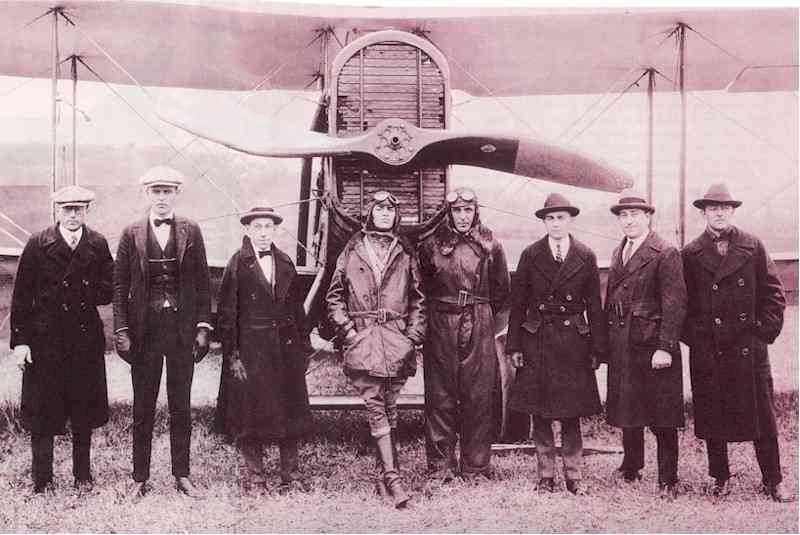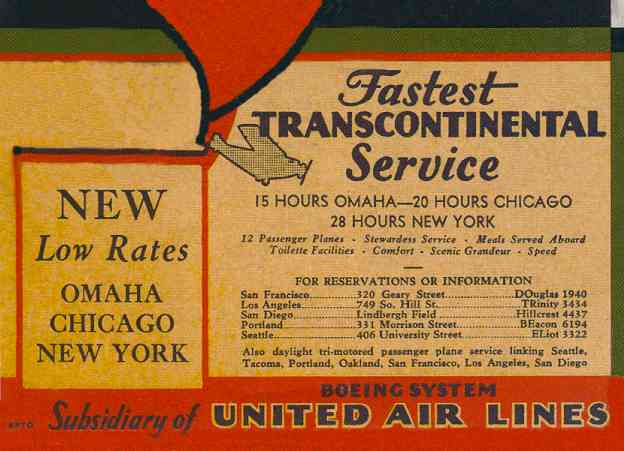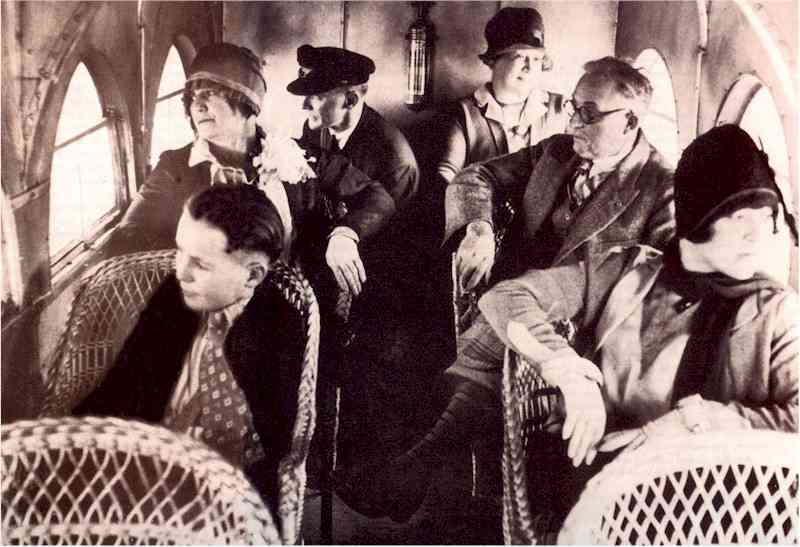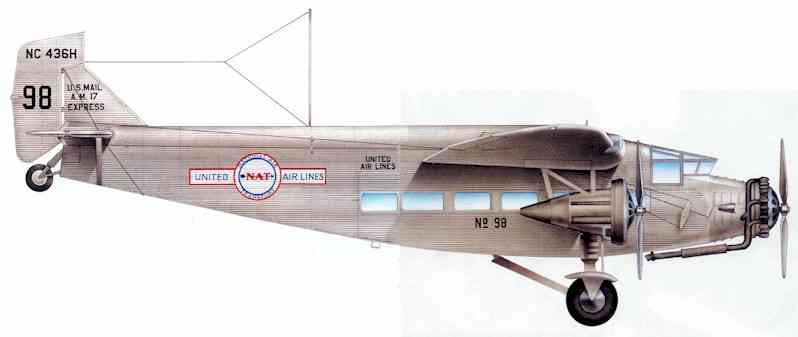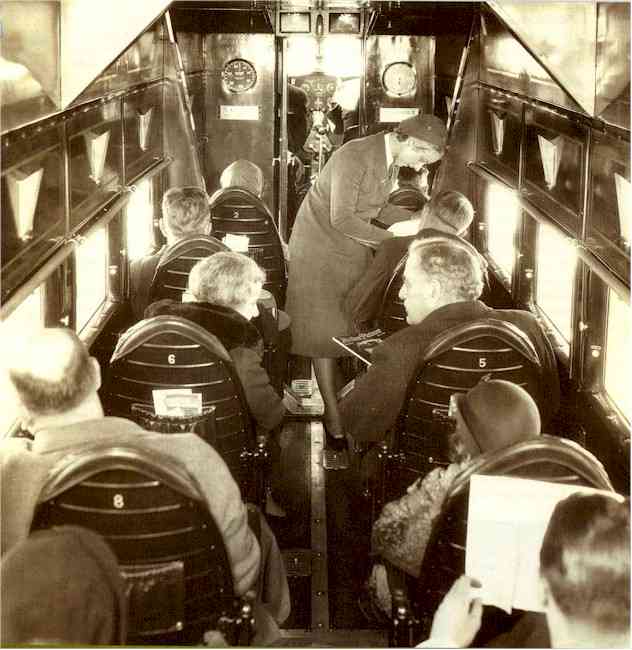History of Flight in the US
Seventy-Five Years UnitedAirmail was an impractical sort of fad, and had no place in the serious job of postal transportation. - Colonel Paul Henderson The explosion of the Challenger, after 24 consecutive shuttle flights, - C Owen Paepke The air is annoyingly potted with a multitude of minor vertical disturbances - Ernest K Gann, describing airline flying in the 1930s by David Fuscher and Bill Garvey When four fledgling airmail carriers were "united," a pioneering aviation company was born. That innovative enterprise would become the world's largest airline. This article is a preview of the upcoming book The Age of Flight: A History of America's Largest Airline. At the end of World War I, the United States had a great fleet of airplanes and hundreds of trained pilots, but there was little for them to do. Many made a meagre living barnstorming across the country, charging spectators at fairs and carnivals as much as $1 just to see an airplane up close. These wood, wire, and cloth planes, with their open one- and two-seat cockpits, had not been built to carry passengers. And most people remained wary of flying. Aviation wasn't yet an industry; it was entertainment. But aviation was bound to play a vital role in the future of the United States, and the government had to find ways to encourage and support its growth. The answer lay with the Post Office Department. Just as pony express riders had forged a trail westward, an airmail service would allow the government to invest in the futUre of aviation while providing an immediate public benefit. In 1918 the Post Office opened an experimental airmail route between New York City and Washington, DC. By 1920 service extended from New York through Chicago to San Francisco following U S Air Mail Route Number 1. That route, called the Overland Trail by pioneers in covered wagons and engineers on the transcontinental railroad, would eventually become known to pilots as the Main Line. When the weather cooperated, it took 78 hours of combined air and rail transport to complete the coast-to-coast journey. Pilots flew only in daylight hours, and despite a chain of primitive landing fields, bad weather or the end of the day often forced them to land in pastures and fields. Delays frequently caused letters to arrive days later than promised. By 1920, air mail was still more of a gimmick than a viable business tool. The experiment was a financial flop, and Congress began to discuss ending it. Post Office officials knew that the only way to save the service was to make it faster and more reliable. But speedier, more modern planes were only in the planning stages. The answer was to begin flying through the night. With no radios and few beacons on the ground to light the way, night flight increased the risk of what was already a dangerous occupation. Within the first three years of airmail service, 19 of the Post Office's original 40 pilots died in crashes. But postal officials believed that a land lighting system could be installed to guide pilots to the dawn. And on 22 February 1921, they were ready to prove that flying mail through the night was a viable option. Two de Havillands started from each coast. Farmers along the way lit bonfires to mark the route. The two planes starting west from New York encountered foul weather and were forced to land. One of the San Francisco-based planes crashed on takeoff from Elko, Nevada. But the other plane, flown by a romantic, leather-clad man named Jack Knight, continued eastward through a snow-filled night, from North Platte to Omaha.
Leather-clad pilot Jack Knight flew into history by making the first nighttime airmail flights. He ended his career as a legendary United captain flying DC-3s on the Main Line. Knight landed only to learn that the ground manager had cancelled all flights east due to a blizzard - if the mail was going to get through, he would have to deliver it. He had never flown the next part of the route before, but by using a road map and following railroad tracks Knight, in his open-cockpit plane, was able to soldier on through bitter cold, snow, and fog all the way to Chicago and into history. There, Knight's mail sacks were transferred to awaiting plane. Reaching New York 33 hours and 20 minutes after departing from San Francisco, the flight forever established the viability of air mail. Almost immediately, Congress granted the Post Office the money to build airports and install beacons to make the service as safe as possible. It was still extremely dangerous work, and a lot of daring young pilots lost their lives flying the mail. But by 1925 airmail planes were crisscrossing the country day and night, and there was tremendous pressure on Congress to turn the system over to private companies. The railroads were complaining loudly that they could not afford to compete with the government-owned operation. And the Post Office was itself heavily burdened by running a vast airline network. Then Congress passed the Air Mail Act of 2 February 1925, also called the Kelly Act, "to encourage commercial aviation and to authorise the Postmaster General to contract for the mail service." The Post Office would pay private operators to transport the mail, and for the first time in history there was real money to be made flying airplanes. Commercial aviation in the United States was born. Of the many Contract Air Mail routes that were created, none was less appealing than CAM 5. It stretched from the small town of Pasco in eastern Washington state through Boise, Idaho, to Elko, Nevada - a 460-mile run "from nowhere to nowhere" over barren, high desert and blizzard-blasted mountains. There was logic behind the difficult route. Pasco was a rail center, roughly equidistant from Portland, Seattle, and Spokane. Mail trains leaving those cities in the evening arrived in Pasco early the next morning. There, mail would be transferred to the contract mail carrier and then flown through Boise and on to Elko, where it was exchanged with mail coming to the Northwest on Post Office planes flying across the Main Line. After carefully studying the various mail routes, Walter T Varney, a flight school and air taxi service operator from San Francisco, concluded that CAM 5 was so uninviting that no one else would want it. He was right. His bid of eight cents per ounce was the only one submitted. Varney bought six small Swallow biplanes able to accommodate one pilot and 600 pounds of mail each. The airplanes arrived unassembled at the new Boise Airport where Varney's chief pilot, Leon "Lee" Cuddeback - a former instructor at the flight school - and his mechanics put them together. Cuddeback's hangar had been erected not long before as part of a forward-thinking municipal project. The airport was about to bring Boise into the aviation age. They had three of the Swallows airworthy, and Cuddeback was in the hangar helping to assemble the fourth late on the afternoon of 6 April 1926, when a telegram arrived. It was bad news. Earlier that day two Varney pilots (one scrunched in the mail pit) had taken off in a Swallow to position the aircraft in Pasco. A forced landing broke both pilots' noses and the two airmen were in the hospital. The timing could not have been worse. Varney's airmail service was scheduled to begin the following day. Cuddeback had no choice. He got in another Swallow and took off for Pasco, 280 miles to the northwest on the other side of the Blue Mountains. It was dark by the time the 27-year-old airman arrived - fortunately, resourceful locals had lined their cars along the runway's edges and turned on their headlights. After a few hours of sleep, Cuddeback downed some coffee and returned to the airport oblivious to the significance of what he was about to do: pilot the first contract mail flight in the Northwest. The importance wasn't lost on others. When he reached the airport at 5:30 am, Cuddeback was shocked to find reporters, photographers, postal officials, and 2,500 onlookers. Cheers filled the morning air as a stagecoach pulled by a team of six horses arrived to trans£er 9,285 pieces of mail weighing a total of 200 pounds. Finally, after 20 minutes of trying, the balky Curtiss K6 engine caught and Cuddeback roared off for Boise. Once en route and free of the morning's tension and unexpected spectacle, Cuddeback realised he hadn't used a restroom in Pasco and now the coffee was having its effect. He made a perfect three-point landing in Boise at 10 am. As he rumbled up to the company hangar, he was dismayed to see another crowd as boisterous as the one he'd left in Pasco. More photographers, more officials, more speeches, more discomfort. He loaded more mail and a special express package from the local American Legion - two prize Idaho potatoes addressed to President Coolidge in Washington, DC. Cuddeback didn't get a moment alone during his stop in Boise, and by the time he took off for Elko at 10:55 he was ready to burst. Predictably, another crowd waited at the next airport, but Cuddeback was less anxious about these ceremonies. (He later revealed that en route to Elko he used one of his gauntlet-like flying gloves for an unorthodox but urgent matter. The glove was discarded over the side and Cuddeback arrived at Elko much relieved.) Cuddeback's inauguration of airmail service was successful, but problems quickly arose. After one week, Walter Varney had to concede that the Swallows were underpowered. He received permission from the Post Office to suspend operations temporarily and install more-powerful Wright Whirlwind J4 engines. Cuddeback and his pilots were back in the air within 60 days and the service continued uninterrupted until 1934, when Varney and three other affiliated airlines - Boeing Air Transport, Pacific Air Transport, and National Air Transport, were united under the name United Air Lines. By 1930, planes weren't just carrying mail. With the Air Commerce Act of 1926, the government had decided to oversee aviation in much the same way it regulated the maritime industry. Just as the government provided navigational services for ships at sea, it wanted to play a similar role in "ports of the air," or "airports." The Department of Commerce started developing a national airways system equipped with radio range beacons, lights to aid navigation, and control towers to supervise traffic. And it set out to popularise flight.
Aviation was hip. Passengers, who once were squeezed into the mail compartments of biplanes, were no longer considered nuisances. They had become the focus of fledgling airlines, and new planes featured unheard-of space for air travelers. To serve them, the first male fight attendants, "cabin boys," as they were called, were hired by Britain's Daimler Airways in 1922. They served no refreshments, but their presence added a comfortable formality to the flight. Four years later, Stout Air Service, which eventually was acquired by United, hired the first U S inflight service personnel - young men officially known as "aerial couriers." Aviation was a man's world - dirty, daring, and sometimes dangerous. During a rough flight between Salt Lake City and San Francisco where both the pilot and copilot had to remain in the cockpit, Steve Stimpson, a traffic manager for Boeing Air Transport in San Francisco, had taken over some of the copilot's extended duties, handing out sandwiches, pouring hot coffee from a thermos, and reassuring passengers. As a way to promote Boeing's service, he suggested and received permission to hire several stewards to serve passengers. No "sensible" person believed women were suitable for work in aviation. All that changed in 1930. A young nurse named Ellen Church was window-shopping in downtown San Francisco when she came upon the Boeing Air Transport office and read promotions about its new Model 80A passenger transports. Church was a woman ahead of her time. In 1930, young women were expected to assume traditional roles - housewife, teacher, office worker - and she complied by becoming a nurse. But Ellen Church had a yearning for adventure. Church's journey began at the University of Minnesota, where she earned a degree in nursing in 1926. From there, she traveled on to San Francisco and was hired by the French Hospital, becoming an instructor of nurses. But once she was on her own and earning a living, the adventurer within surfaced. During World War I, when she was a little girl, she had spent hours watching servicemen learning to fly in a pasture next to her family's farm. She was mesmerized by the wailing engines, the endless flow of takeoffs and landings. She wanted to be a part of it all. A decade later, Church went down to the little airfield near San Francisco Bay, pulled out her wallet, and asked to be taught to fly. Soon she was wheeling and soaring over the peninsula, an aviatrix in the making. But then, as now, flying was an expensive pursuit. And there was no place for a female pilot at any of the fledgling air carriers. So when she paused outside Boeing's ticket office, she turned the knob and walked in. It was a holiday, and manager Steve Stimpson was alone without much to do. The two struck up a conversation about aviation and air travel. It was then that Church learned the airline was about to hire male stewards to attend to passengers in flight. "Why wouldn't a girl with nurse's training do a better job serving lunch and looking after passengers on a plane?" she asked. "Mr Stimpson," she continued, "if women were casually living in the air, choosing to work there, wouldn't it have a good psychological effect and help to rid the public of any fear?" Although Boeing executives initially turned down the idea, it was eventually approved by Pat Patterson - who would become the visionary president of United Air Lines. A new and groundbreaking profession for women had been born. For the first time, the concept of inflight service had been institutionalised. The profession would become synonymous with glamour and world travel. But it didn't begin as a glamorous profession. Stimpson hired eight registered nurses, primarily because "they are not given to flightiness - I mean, in the head. The average graduate nurse is a girl with some horse sense and is very practical and has seen enough of men to not be inclined to chase them around the block at every opportunity." These Sky Girls, as they were being called by some, were paid $125 a month to fly a minimum of 100 hours. Although there was no formal training, Ellen Church and Steve Stimpson developed the first manual. In addition to serving meals, the many other tasks expected to be performed by these stewardesses - the job title bestowed "until a more suitable name can be found," wrote Church - included welcoming passengers, punching their tickets and giving refunds when necessary at each stop, weighing the passengers and their baggage, loading and unloading that baggage, making sure the wicker seats were bolted down, dusting the windowsills, carrying buckets of fuel to the plane when necessary, swatting flies in the cabin, and ensuring that the passengers did not throw lighted cigarettes out the windows or mistakenly open the emergency exit door when they intended to use the "blue room," or lavatory.
Only 28 hours to New York! The Ford Trimotor was equipped with amenities touted in early ads: wicker chairs, stewardess service, A commercial aircraft is a vehicle capable of supporting itself aerodynamically and economically at the same time. - William B Stout, designer of the Ford Trimotor
Ford Trimotor 5 AT D began service in 1931; Wingspan 77' 10"; Length 49' 10"; Cruise speed 115 - 122 mph Stewardesses mopped the floor when the toilet overflowed, adjusted the clocks and altimeters in the cabin, handed out chewing gum, blankets, ammonia capsules, and slippers on night flights, cleaned passengers' shoes, swept the floor, and carried a railroad timetable in case connections had to be made. Once finished for the night, they helped push the airplane into its hangar before heading home. When a plane was forced to land in a farmer's field, the stewardess helped knock down fences to enable the plane to take off safely. Inez Keller Fuite, one of the Original Eight stewardesses, recalled one such incident. "The plane ran out of gas and had to make an emergency landing in a wheat field. People from the surrounding area came in wagons and on horseback to see the plane. They'd never seen an aircraft before, and they wanted to touch it and to touch me. One of them called me 'the angel from the sky.'" Initially the Original Eight received quite a bit of resistance from pilots, who at first refused to speak to them. Pilots' wives were clearly unhappy about attractive single women travelling with their husbands. But the pilots were quickly won over by the dedication and professionalism of the new attendants. The passengers needed little convincing; they loved the flight attendant concept. Stimpson's experiment was a success, and Boeing hired an additional 20 Sky Girls. Within a year, most major U S airlines were hiring women. Boeing applicants had to be under 25 years old, no more than 5 feet 4 inches tall, and weigh qo more than 115 pounds. They had to be registered nurses. And perhaps strictest of all, the applicant had to be single - one of the Original Eight was married and her frantic husband called Steve Stimpson every time her flight was late. Stewardesses initially wore nurselike uniforms and caps in flight and at other times wore a standard uniform designed by Stimpson and Church - a dark-green wool cape lined with gray, a double-breasted suit jacket worn over a white roundneck blouse, a calf -length skirt with front pleats, and black oxfords with sensible heels. The only problem was turnover. When young, attractive, single women worked on an airplane, they very often met young, attractive, successful, single men and got married. Prior to World War II, the average length of employment was slightly more than one year. To replace departing stewardesses, United instituted a training program. By 1936, United opened the first stewardess training center. During the course, young women were taught how to take tickets, serve a hot meal, and perform safety procedures - as well as take the name and address of every passenger should there be a problem during the flight so that the airline could send letters of apology.
By 1930, the luxurious cabin interior put passengers in the reassuring setting of a train coach. Being a stewardess was already a profession, but now stewardesses were becoming professionals. And glamorous ones at that. The media created the image of the stewardess - lovely young women flying all over the United States leading adventurous, romantic lives. And that image was pretty much true. In 1940, United's earliest inflight magazine gushed, "If you select one group of American girls which, more than any other, represent beauty as a class, it wouldn't be dancers, debutantes, chorus gitls or the much glorified movie starlets. It would not be models, they are more often pretty and vapid than beautiful. The one group today building up the right to that designation is the airline stewardess. They've got an alert look about them that's fascinating ...and they can't have that world-weary expression which some girls believe devastating and everybody else regards as a pain in the neck." These were intelligent, accomplished women in the public eye - and the public was wowed. It would soon be more impressed. In 1942, stewardesses, whose nursing training was desperately needed, went to war. United's planes, pilots, mechanics, and ground crews were enlisted in a global supply network that taught the airline that its wings could reach far beyond the Main Line. Many stewardesses, including Ellen Church, were decorated for service as flight nurses during daring evacuations. Books and movies made them heroes. The future held more changes. In 1945, United recognised the first stewardesses' union. And two decades after the first stewardesses were hired, United once again began hiring male stewards. Eventually, the existence of a mandatory retirement age was ruled illegal. Stewardesses were even permitted to continue working while pregnant. Then came a name change. Everything from "air hostess" to "airess" had been considered. But at the beginning of the 1970s the title "stewardess" was replaced by the more professional and gender-neutral description "flight attendant." Commercial aviation got a late start in the United States. By the time U S airline companies began carrying sacks of mail in 1926, overseas carriers were making regularly scheduled passenger flights in 17 European countries, as well as on the continents of South America, Australia, and Africa. But by the decade before World War II, the infancy of commercial aviation was coming to an end in North America. In 1927, mail carriers Boeing Air Transport and National Air Transport, two of United's predecessor airlines, joined segments to create the irregularly scheduled first transcontinental passenger service between San Francisco and New York City. In a few short years, United's pilots, stewardesses, and thousands of people behind the scenes were turning the dream of transcontinental flight into a daily occurrence. In 1929, Boeing and NAT introduced trimotor transports designed specifically to carry 12 to 18 passengers in an enclosed cabin. These faster planes cut the cross-country journey to only 28 hours, and increased capacity allowed the airlines to reduce the fare to $259.50 (about US$2,500 in today's dollars). They followed the same route, but what was once known as U S Mail Route Number 1, which was quickly becoming known across the nation as the Main Line. While flights were scheduled to leave at a specific time, that time varied much more than it does today - the weather, availability of the airplane and pilots, and the arrival of the passengers posed substantial challenges. By 1929, most airline passengers were travelling on personal emergencies or for business - some 80 leading U S corporations permitted key employees to put airfares on their expense accounts. That transcontinental flight experience was vastly different than it is today. Before departing from San Francisco's Mills Field, which had opened in 1927, white-jacketed stewards weighed and tagged luggage, collected tickets, and explained safety regulations to the passengers. They distributed comfort packages that included cotton balls for the ears and chewing gum for dealing with changes in air pressure. Most flights were still taking off in bright daylight, although the government's nationwide system of lighted airway beacons every 30 miles had been completed. The first stop was Reno, Nevada, two hours away, where planes would meet connecting flights from Los Angeles, San Diego, the Pacific Northwest, and Montana. The interior of the cabin was designed to put passengers in the reassuring setting of a train coach. The mailbags and hard benches had been replaced by upholstered chairs and a cabin spacious enough for walking around. Most such planes flew at 14,000 feet. But the uninsulated cabin was chilly in winter and warm in summer, so the windows slid open or rolled down to provide fresh air. But open windows also drew engine fumes into the cabin. The biggest problem was the noise of the engines, which most times made normal conversation impossible. Planes had primitive toilet facilities, including a small sink with hot and cold running water, but the toilet itself was simply a seat that opened to reveal a hole in the floor. In the enclosed cockpit the two pilots often referred to their old logbooks compiled over years of flying and thousands of miles. The books noted all the major landmarks, the compass headings, and the time needed to fly between landmarks on the major routes. But these pilots also had a directed radio beam to mark their course. The trimotors raced over the country at speeds reaching 120 miles per hour, covering more land in eight minutes than the pioneers did in an entire day. Chicago, the aviation hub of the United States, was six stops and 20 hours from San Francisco. The planes had to fly through, rather than over, bad weather. Flights often ended prematurely and passengers had to be transported by car, truck, bus, or even ferry to the nearest railway station to continue their journey. Fortunately, cities small and large had built landing fields in hopes of attracting some of the 61 U S airlines. Most landing strips were little more than packed dirt. Planes parked under a roof only on the nicest fields, permitting passengers to avoid bad weather. There were few amenities onboard. For entertainment, passengers tracked their altitude and speed using an altimeter and airspeed indicator mounted on the forward cabin wall. This was aviation's "fried-chicken era." The chicken came wrapped in wax paper and was accompanied by a bag of potato chips and a tomato. Boeing began serving cold sandwiches and fruit in a papier-mache box. Coffee and cold water were served from half-pint thermos bottles. Boeing introduced a small shelf that could be used as a lunch table, and it began serving more elaborate meals, including a chicken casserole. But a lot of passengers had no interest in eating. Flying was particularly hard on the stomach. After the 20-hour flight from the West Coast to Chicago's Municipal Airport, New York was less than seven hours away. At least part of this 1,200-mile leg took place at night, when passengers could, for the first time, marvel at the world of lights below. The Main Line flights landed at Newark, the first major airport serving New York City. There, weary passengers transferred to other, more conventional, modes of transportation. Commercial air travel was still young, and as these early passengers jostled along by car and train to their final destinations, it's easy to imagine the amazement they must have felt at so suddenly being on the opposite side of the United States. By the 1930s, the Main Line, and the United Mainliners that traversed it, had become synonymous with the cutting edge of aviation. DC-3s were making the cross-country flight in less than 16 hours. Sleeper plane advertisements promised "Good night New York ...Good morning California." Jack Knight, the airmail pilot who flew through the snow to Chicago and into history, followed his night flight feat with a long United career flying Mainliners. Men like Knight and H W Huking, also a United captain who flew on the original airmail route in 1918, knew they were pioneers - they'd gone from flying flimsy craft to piloting planes that were huge and sophisticated. When United's ads pronounced the 1940s the "Age of Flight" and announced "The Pioneering Is Done," they, perhaps more than most, were comfortable with that assessment. Knight was retired by then and was regarded as having flown more miles than anyone alive. Though the legendary United captain was confident of his place in aviation history, he said, "I dare not make a prophecy for the next 20 years for fear my vision will fall far short of reality." Undoubtedly he sensed that the pioneering had really only just begun. David Fischer and Bill Garvey collaborated on Wild Blue, a 1999 aviation anthology. Their book, The Age of Flight: A History of America's Pioneering Airline was published in June 2001 Source: Hemispheres Magazine May 2001; you can find them on the web at www.hemispheresmagazine.com For a review of an excellent book (written by someone from New Jersey named Rinker Buck) called If We Had Wings - a lyrical discourse on the history of flying by someone with a story of his own to tell - click here (this is the only reference to this page).
To view other articles related to flying including history, unusual flying machines, hot air balloons, skydiving, gliding, problems, airports, turbulence, pilots, crashes, the Paris
Air Show, the future, blimps, space travel, solar sails and more, clicking the "Up" button below takes you to the Table of Contents for this section on Flight. |
 Animals
Animals Animation
Animation Art of Playing Cards
Art of Playing Cards Drugs
Drugs Education
Education Environment
Environment Flying
Flying History
History Humour
Humour Immigration
Immigration Info/Tech
Info/Tech Intellectual/Entertaining
Intellectual/Entertaining Lifestyles
Lifestyles Men
Men Money/Politics/Law
Money/Politics/Law New Jersey
New Jersey Odds and Oddities
Odds and Oddities Older & Under
Older & Under Photography
Photography Prisons
Prisons Relationships
Relationships Science
Science Social/Cultural
Social/Cultural Terrorism
Terrorism Wellington
Wellington Working
Working Zero Return Investment
Zero Return Investment